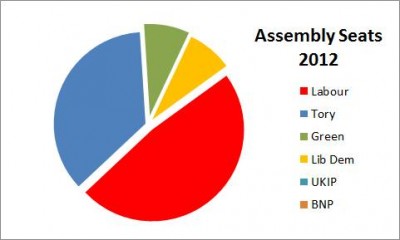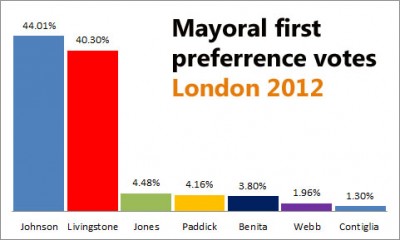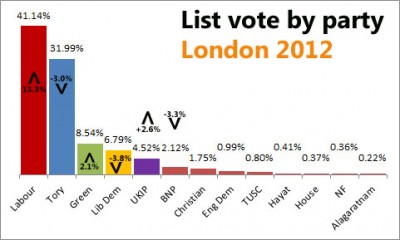First a quick look at the Mayoral vote.
Livingstone improved his performance on last time, perhaps dispelling the idea that he had lost support over the years. It should perhaps be pointed out tough that although his share went up the number of people voting for him went down (same with Boris) due to the drastically reduced turnout. It’s clear that it was Johnson’s ability to out pull his own party that has put him into the Mayor’s chair rather than Livingstone’s inability to win Labour supporters.
That is not to say that a “better” Labour candidate could not have laded some killer blows on Johnson, rather than spending most of he campaign on the defensive over peripheral issues, or to find that many members of the public did not believe key election pledges. A Labour candidate who could have kept the Labour turnout up would have won, but whether that as even possible is pure speculation.
Brian Paddick managed to avoid being put into fifth place by Siobhan Benita but both he and the BNP more than halved their votes. hile UKIP doubled theirs and the Greens showeed a mared imprvement.
However, the main interesting point here is hat despite the second preference voting system allowing people to vote for “hopeless” candidates without jeopardising the chances of the least bad of the top two the vast majority of people voted for Johnson or Livingstone. his is probably because they were most people’s first choices (rather than people voting “wrongly”)
| 1st prefs | Change | ||
| Johnson | Con | 44.01% | +1.53 |
| Livingstone | Lab | 40.30% | +3.92 |
| Jones | Grn | 4.48% | +1.33 |
| Paddick | LD | 4.16% | -5.47 |
| Benita | Ind | 3.80% | – |
| Webb | UKIP | 1.96% | +1.05 |
| Contiglia | BNP | 1.30% | -1.54 |
We’l bring you the full second preference table once we have the numbers for all the candidates.
The Assembly votes
As you will undoubtedly know by now the Assembly was won by Labour, here’s a breakdown of the number of seats;
| Seats | Change | |
| Labour | 12 | +4 |
| Tory | 9 | -2 |
| Green | 2 | 0 |
| Lib Dem | 2 | -1 |
| BNP | 0 | -1 |
The key here is the two thirds majority that the opposition needs to vote down the Mayor’s budget. Sadly the combined weight of the non-Tory parties don’t quite add up to 18, however it does add pressure on the Conservative group to a) actually turn up to votes and b) not to dissent from the majority position (although the last four years of the Assembly saw few, if any, significant splits in party groups).






2 Comments
“Livingstone improved his performance on last time, perhaps dispelling the idea that he had lost support”
Given the national swing to Labour, this was any Labour candidate’s election to lose, and Livingstone lost it. Just compare the Assembly result with the Mayoral result to see the extent of the Livingstone disaster. Livingstone’s assistance to clerical fascists is not a misinterpretation or a mistake – essentially he recruited his supporters in one market and sell them in another, very different one. Most of those supporters didn’t figure out that he betrayed them, but he did so, as surely as if he had assisted the BNP.
The difference between Livingstone’s first preference votes and Labour’s list vote was less than 1%.
Given that Livingstone is used to outpolling his own party it is a step backwards for him, but it doesn’t provide any evidence that he’s as toxic as some are claiming. It looks far more likely that it was Boris what won it, rather than Livingstone who lost.
A better Labour might have won – but that’s always going to be speculation.